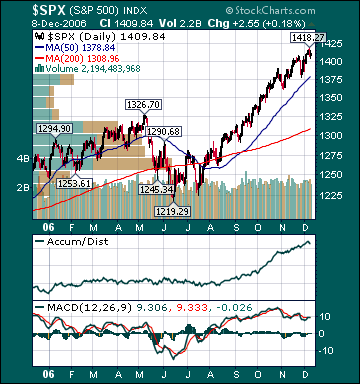There are a number of economic reports of note and some significant corporate earnings reports scheduled for release this week.
Economic reports for the week include:
Mon. - 3Q Current Account Balance, NAHB Housing Market Index
Tues. - Producer Price Index, Housing Starts, Building Permits
Wed. - MBA Mortgage Applications
Thur. - Final 3Q GDP, Final 3Q GDP Price Index, Final 3Q Personal Consumption, Final 3Q Core PCE, Initial Jobless Claims, Leading Indicators, Philadelphia Fed.
Fri. - Personal Income, Personal Spending, PCE Deflator, Durable Goods Orders, Final Univ. of Mich. Consumer Confidence
Some of the more noteworthy companies that release quarterly earnings this week are:
Mon. - CSK Auto(CAO), Hovnanian Enterprises(HOV), Joy Global(JOYG), Oracle Corp.(ORCL), Steelcase(SCS)
Tues. - Chaparral Steel(CHAP), Christopher & Banks(CBK), Cintas(CTAS), Circuit City(CC), Darden Restaurants(DRI), Factset Research(FDS), FuelCell Energy(FCEL), Lennar Corp.(LEN), Morgan Stanley(MS), Palm Inc.(PALM), Scholastic Corp.(SCHL)
Wed. - 3Com Corp.(COMS), Accenture Ltd(ACN), Actuant Corp.(ATU), Bed, Bath & Beyond(BBBY), Biomet(BMET), Carmax(KMX), Family Dollar(FDO), FedEx Corp.(FDX), Finish Line(FINL), Herman Miller(MLHR), Nike Inc.(NKE), Paychex(PAYX)
Thur. - AG Edwards(AGE), American Greeting(AM), Carnival Corp.(CCL), Commercial Metal(CMC), ConAgra Foods(CAG), General Mills(IS), Micron Tech(MU), Red Hat(RHAT), Resources Connection(RECN), Rite Aid(RAD), Shuffle Master(SHFL), Solectron(SLR), Worthington Industries(WOR)
Fri. - None of note
Other events that have market-moving potential this week include:
Mon. - None of note
Tue. - None of note
Wed. - None of note
Thur. - The Fed’s Lacker speaks
Fri. - None of note
BOTTOM LINE: I expect US stocks to finish the week modestly higher on mostly positive economic data, lower energy prices, seasonal strength, strong corporate profits, bargain-hunting, investment manager performance anxiety and short-covering. My trading indicators are still giving bullish signals and the Portfolio is 100% net long heading into the week.
